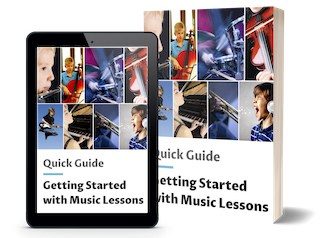Best
Standard Bb Tenor Trombone
-
Overall: Easy To Play With An Accurate And Brilliant Sound
-
Best Feature: With A Yellow Brass Bell For Warm And Clear Tones
-
TedScore™: 10/10
Best
Bass Trombone
-
Overall: Provides Excellent Projection With A Wide Bore Size And Rose Brass Bell
-
Best Feature: Delivers A Wide Range Of Tonal Colours Through The Dynamic Range
-
TedScore™: 9/10
Best
Alto Trombone
-
Overall: With A 7" Bell Providing Excellent Projection
-
Best Feature: Has A Dual-Bore Style For A Wider Sound
-
TedScore™: 8.5/10
Are you keen on brass music? The trombone truly shines with its remarkable and adaptable sound. It pops up in all sorts of music, from classical to jazz to pop. But did you know? There are various kinds!
In this article, we’ll look at the different types of trombones and their characteristics. Whether you’re a beginner or an advanced player, understanding the differences between the types can help you choose the right instrument for your needs and preferences.
Don’t miss out on the unique and versatile sound of the trombone! Join us in exploring the wonderful world of trombones and find the perfect one for you!
History of Trombones
The trombone is a brass instrument that has been around for centuries. Its origins can be traced back to the early 15th century when it was known as the sackbut. The sackbut was similar in appearance to the modern trombone but lacked the slide mechanism, now a defining feature of the instrument.
Over time, the sackbut evolved into the modern trombone. The slide mechanism was added in the late 15th century, and the instrument became increasingly popular throughout Europe. By the 16th century, the trombone was a staple of many musical ensembles.
Discover different types of trombones with pictures below. From the classic tenor trombone to the popular bass trombone and the unique contrabass trombone, explore a range of brass instruments.

During the 17th and 18th centuries, the trombone fell out of favour in secular music, but it remained an important instrument in religious music. It was often used in church choirs and in the orchestras of royal courts. In the 19th century, the trombone experienced a resurgence in popularity. It became a staple of military, circus, and brass bands.
Today, the trombone is still a popular instrument used in various musical genres, from classical to jazz and pop. It’s known for its rich, deep sound and ability to play melody and harmony.
Parts of a Trombone
When understanding the different types of trombones, it’s essential first to understand the different parts that make up the instrument. Here are the three main components of a trombone:

Bell Section
This is the flared end of the trombone that amplifies the sound produced by the instrument. The bell’s shape and size can impact the sound’s tone and projection.
Slide
The slide is the most distinctive feature of a trombone. It consists of two parallel tubes of tubing that move in and out of each other, allowing the player to change the pitch of the notes. The slide is a complex system of braces, crooks, and stockings, which can impact the overall sound and playability of the instrument.
Mouthpiece
The mouthpiece is part of the trombone that the player blows into. It’s a small, cone-shaped piece of metal that can significantly impact the tone and projection of the sound produced by the instrument.
How are the Trombones Different?
When it comes to the trombone family, there are seven different sizes, but only three of them are commonly used. These three sizes are the tenor, bass, and alto trombones, and each has unique characteristics that set them apart. Here are some of the key differences between the different types of trombones:
Sound and Tone
The sound and tone of each trombone vary depending on its size. The tenor trombone produces a warm and mellow tone, while the bass trombone has a deeper and more resonant sound. On the other hand, the alto trombone produces a brighter and more focused sound than the tenor trombone.
Range and Flexibility
The range and flexibility of each trombone also differ. The tenor trombone has a range that extends from the Bb below the bass clef to the Bb above the treble clef. On the other hand, the bass trombone can play even lower notes than the tenor trombone, and its range extends from the F below the bass clef to the F above the treble clef. The alto trombone has a much narrower range than the tenor and bass trombones, but it’s more flexible and can play faster and more intricate passages.
Technical Requirements
Each type of trombone requires different technical skills to play. The tenor trombone is the most commonly used and often the first instrument trombone players learn. The bass trombone requires more technical skill to play because of its larger size and the need for more air support. The alto trombone is the most challenging to play because of its smaller size, faster slide movements, and higher register.
Cost and Availability
The cost and availability of each type of trombone also vary. The tenor trombone is the most widely available and affordable of the three types. The bass trombone is more expensive and less common, while the alto trombone is the rarest and most expensive. However, there are also other less common trombones, and other brass instruments such as the soprano trombone, the sopranino trombone, and the piccolo trombone, which are rarer and more expensive.
The Most Popular Types of Trombone
The Standard Tenor Trombones
The Bb tenor trombone is the most common type of trombone. It’s pitched in Bb and comes in two main variations, with and without an F attachment. The F attachment allows the instrument to play lower notes and use fewer long positions. The tenor trombone also comes in different bore sizes, affecting the instrument’s sound and projection. The most popular bore size is the medium bore, which is versatile and suitable for various musical styles.

DESIGNED FOR: advanced and professional players
FEATURES: With a yellow brass bell for warm and clear tones
OTHER INFO: Easy to play with an accurate and brilliant sound
King 3B Tenor Trombone
When you check the price above, you’ll see there are loads of great places to buy this item. Our personal favorite is Gear4music.
It is the largest music retailer in the UK and fast becoming the most respected online music shop in the US too. Their customer service is excellent, they have competitive prices, really fast shipping, and usually have the longest guarantee.
Most professional musicians use Gear4music, so there is no reason why you shouldn’t too!
- Finished with a bright clear lacquer for additional tonal warmth
- Famed for its excellent versatility
- Includes wood shell case and mouthpiece
- Not easy to find
The professional musician who wrote this article combined many things,
from the product build, manufacturer’s reputation through to feedback
from other users, to create our famous TedScore™.
The Bass Trombones
The bass trombone is larger and lower-pitched than the tenor trombone. It’s often used in orchestras and jazz ensembles to provide a deep, rich bass sound. The bass trombone has one or two valves, which allow the player to extend the range of the instrument and play lower notes.

DESIGNED FOR: progressing students or professional musicians
FEATURES: Delivers a wide range of tonal colours through the dynamic range
OTHER INFO: Provides excellent projection with a wide bore size and rose brass bell
Conn 62HI Bass Trombone
When you check the price above, you’ll see there are loads of great places to buy this item. Our personal favorite is Gear4music.
It is the largest music retailer in the UK and fast becoming the most respected online music shop in the US too. Their customer service is excellent, they have competitive prices, really fast shipping, and usually have the longest guarantee.
Most professional musicians use Gear4music, so there is no reason why you shouldn’t too!
- With perfectly smooth chrome-plated inner slides for effortless action
- Ideal for either symphony orchestras or brass groups
- Comes with a Conn mouthpiece and instrument case
- Higher price range compared to other models
The professional musician who wrote this article combined many things,
from the product build, manufacturer’s reputation through to feedback
from other users, to create our famous TedScore™.
The Alto Trombones
The alto trombone is a smaller and higher-pitched version of the tenor trombone. It’s often used in orchestral and chamber music to provide a higher, more delicate sound. The alto trombone is tuned to Eb or F, and some models have a trigger or valve to extend the range of the instrument.

DESIGNED FOR: advancing students or professional musicians
FEATURES: Has a dual-bore style for a wider sound
OTHER INFO: With a 7" bell providing excellent projection
Conn 34H Alto Trombone
When you check the price above, you’ll see there are loads of great places to buy this item. Our personal favorite is Gear4music.
It is the largest music retailer in the UK and fast becoming the most respected online music shop in the US too. Their customer service is excellent, they have competitive prices, really fast shipping, and usually have the longest guarantee.
Most professional musicians use Gear4music, so there is no reason why you shouldn’t too!
- A large yellow-brass bell that gives excellent projection and tonal warmth
- Boasts perfectly smooth inner slide tubes for effortless action and playability
- High-performance alto trombone
- Comes with a mouthpiece and instrument case
- A little pricey compared to other brands
The professional musician who wrote this article combined many things,
from the product build, manufacturer’s reputation through to feedback
from other users, to create our famous TedScore™.
The Contrabass Trombones
The contrabass trombone is the largest and lowest-pitched member of the trombone family. It’s rarely used in orchestras and bands but sometimes in film scores and avant-garde music. The contrabass trombone has a very deep, powerful sound and requires a lot of air to play.

DESIGNED FOR: intermediate to advanced level players
FEATURES: Has a key of Bb, which is the standard key for most trombones
OTHER INFO: With a bore size of .562 inches, that provides a deep, rich sound
O'Malley Instruments Contrabass Trombone
When you check the price above, you’ll see there are loads of great places to buy this item. Our personal favorite is Gear4music.
It is the largest music retailer in the UK and fast becoming the most respected online music shop in the US too. Their customer service is excellent, they have competitive prices, really fast shipping, and usually have the longest guarantee.
Most professional musicians use Gear4music, so there is no reason why you shouldn’t too!
- Produces a full, resonant tone with its large bell size
- An affordable option
- Comes with a hard case for protection during transportation
- Some users reported that it can be difficult to hear in large ensembles
The professional musician who wrote this article combined many things,
from the product build, manufacturer’s reputation through to feedback
from other users, to create our famous TedScore™.
The Soprano Trombones
The soprano trombone is a small and high-pitched version of the tenor trombone. It’s rarely used in orchestras and bands but sometimes in chamber music and solo performances. The soprano trombone is tuned to Bb or C and has a bright, clear sound.

DESIGNED FOR: intermediate to advanced level players
FEATURES: With an ABS plastic body that's lightweight yet durable
OTHER INFO: Comes with a silver-plated mouthpiece that produces a clear and bright tone
Thomann SL 5 Soprano Trombone
When you check the price above, you’ll see there are loads of great places to buy this item. Our personal favorite is Gear4music.
It is the largest music retailer in the UK and fast becoming the most respected online music shop in the US too. Their customer service is excellent, they have competitive prices, really fast shipping, and usually have the longest guarantee.
Most professional musicians use Gear4music, so there is no reason why you shouldn’t too!
- Compact size for easy transportation and storage.
- An excellent addition to any jazz band or orchestra
- Includes case, trumpet mouth pipe and accessories
- The smaller size may make it harder to play for those used to larger trombones
The professional musician who wrote this article combined many things,
from the product build, manufacturer’s reputation through to feedback
from other users, to create our famous TedScore™.
The Piccolo Trombones
The piccolo trombone, the tiniest and highest-pitched instrument in the trombone family, is seldom employed in orchestras and bands but is occasionally used in chamber music and solo trombonists’ performances. Tuned to Eb or F, it produces a vibrant and penetrating sound.

DESIGNED FOR: intermediate and professional-level players
FEATURES: Boasts a high Bb key (like a piccolo trumpet in Bb)
OTHER INFO: Has a bore that measures 0.46" (11.7mm). With a gold brass bell measuring 3.94" (100mm)
Piccolo Trombone – PB300 by Wessex Tubas
When you check the price above, you’ll see there are loads of great places to buy this item. Our personal favorite is Gear4music.
It is the largest music retailer in the UK and fast becoming the most respected online music shop in the US too. Their customer service is excellent, they have competitive prices, really fast shipping, and usually have the longest guarantee.
Most professional musicians use Gear4music, so there is no reason why you shouldn’t too!
- Includes a trumpet mouthpiece
- Also comes with a wooden leather-look case
- May take some time to adjust to the tighter embouchure required to play this instrument
The professional musician who wrote this article combined many things,
from the product build, manufacturer’s reputation through to feedback
from other users, to create our famous TedScore™.
The Valve Trombones
The valve trombone is a variation of the tenor trombone that uses valves instead of a slide to change the pitch. It’s often used in jazz and pop music to provide a smoother, more legato sound. The valve trombone has a different playing technique, higher than the tenor slide trombone and requires a different type of mouthpiece.

DESIGNED FOR: student-level players
FEATURES: With stainless steel pistons for smooth, fast action
OTHER INFO: Professional-looking lacquered brass body
Jupiter JTB700V Valve Trombone
When you check the price above, you’ll see there are loads of great places to buy this item. Our personal favorite is Gear4music.
It is the largest music retailer in the UK and fast becoming the most respected online music shop in the US too. Their customer service is excellent, they have competitive prices, really fast shipping, and usually have the longest guarantee.
Most professional musicians use Gear4music, so there is no reason why you shouldn’t too!
- Holds accurate tuning in all registers
- Versatile and compact
- Built using state-of-the-art technology
- Includes hard shell case and mouthpiece
- The valve casing can be prone to corrosion over time if not properly maintained
The professional musician who wrote this article combined many things,
from the product build, manufacturer’s reputation through to feedback
from other users, to create our famous TedScore™.
Tips for Selecting the Right Trombone Type for You
Choosing the right trombone type can be daunting, especially if you’re a beginner. Here are some tips to help you select the perfect trombone for you:
Tip #1: Determine your skill level. Starting with a straight tenor trombone is recommended if you’re a beginner. This type of trombone is easier to play and is perfect for beginners. If you are an intermediate or advanced player, consider a tenor trombone with an F attachment or a bass trombone.
Tip #2: Consider the type of music you will be playing. Different types of music require different types of trombones. A straight tenor trombone is a great option if you’re playing jazz. If you’re playing classical music, a tenor trombone with an F attachment or a bass trombone is more suitable.
Tip #3: Think about your budget. Trombones can be expensive, so it’s important to consider your budget before purchasing. If you’re a beginner, you can start with a student-model trombone, which is more affordable. You may want to invest in a professional model trombone if you’re an intermediate or advanced player.
Tip #4: Consider the bore size. The bore size of a trombone affects the sound it produces. A larger bore size produces a bigger and more powerful sound, while a smaller bore size produces a brighter and more focused sound. Consider your preference and the type of music you will play when choosing a bore size.
Tip #5: Try before you buy. It’s important to try out different types of trombones before making a purchase. This will help you determine which type of trombone feels comfortable and sounds best to you.
Trombone Types
Summary
Congratulations on making it to the end of our guide to trombone types! We hope you had a blast discovering all the fascinating information we shared. Whether you’re a newbie or an experienced player, there’s always something new to learn about these awesome instruments.
When choosing the perfect trombone for you, remember to consider factors like the bell’s material, the type of tuning slide, and the size of the mouthpiece. And don’t be afraid to try out different types of trombones until you find the one that speaks to your soul.
Now, here’s our challenge to you: keep exploring and learning about the world of trombones! Whether jamming in a band, playing in an orchestra, or just having fun with student trombones, the trombone is a versatile and rewarding instrument that can bring you and your audience joy. Keep on playing and keep on grooving!
One quick thing…
Have you decided on the best type of trombone for you? If you’re ready to take on the next musical adventure, check out this list of the best trombone brands for beginners!
FAQ's
The trombone family contains seven sizes, but only three are regularly seen. The three sizes of trombones are contrabass, bass, and tenor.
The most commonly played trombone is the tenor trombone, pitched in Bb and comes in two main variations, with and without an F attachment. The tenor trombone is also available in different bore sizes.
The two types of trombones are the tenor and bass trombones, with the tenor being the most commonly played. However, an alto trombone is sometimes used in an orchestra section of three trombones.
A tiny trombone is called a soprano trombone or a slide trumpet. It’s pitched higher than the standard Bb tenor trombone and is sometimes used in baroque and early classical music.
The weight of a trombone can vary depending on the type of trombone and the materials used in its construction. On average, a tenor trombone weighs between 1.5 and 2.5 kilograms (3 to 5.5 pounds).
The price of a trombone can vary considerably based on factors like the brand, quality, and materials used in its construction. Beginner-level trombones can cost anywhere from £/$300 to £/$1,000, while professional-grade instruments can cost upwards of £/$3,000 or more.











In your section detailing the bass trombones, you mentioned their ‘increased range and flexibility’. However, it’s critical to clarify that while bass trombones offer a lower pitch and wider bore, enhancing their lower range, they do not inherently provide more flexibility than tenor trombones. Flexibility is more a function of player skill than instrument characteristics. Clarification would benefit your readers greatly, Rory Cartmell.
didn’t know there were so many trombones, interesting read
love the breakdown of the parts, especially the slide part, always wondered about the mechanics, thx for sharing!
Rory Cartmell, appreciate the insights on the different trombone types. I’m curious about how the soprano trombone fits into school bands and ensembles, given its unique sound profile. Have you encountered bands successfully incorporating this instrument into their arrangements?
Soprano trombone sounds cool! Hard to play?
Had a kid play the soprano trombone in our jazz ensemble last year. Tricky to balance but it added a nice color!